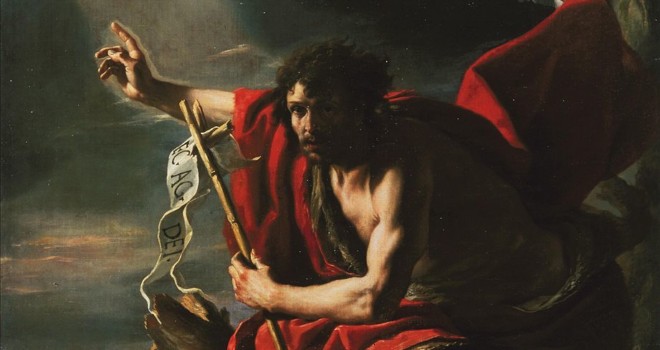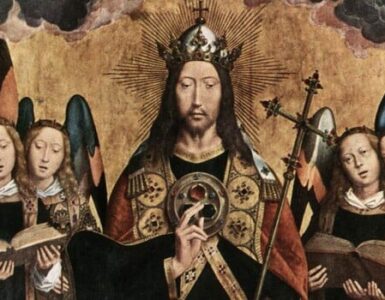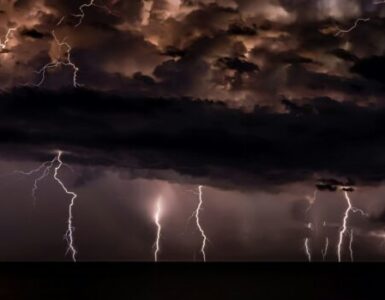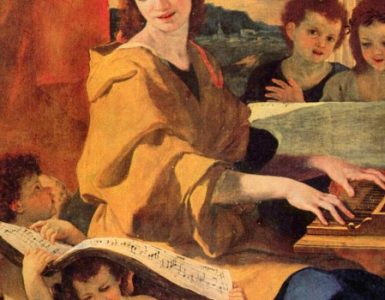Viewing and pondering sacred art offers the faithful a great way to prepare for the birth of Our Blessed Lord at Christmas. This series of articles will highlight several pieces of art related to the Gospel readings of this year’s lectionary cycle, as well as two pieces related to the week leading to Christmas. Each of these pieces of art allows us to reflect deeply on God’s plan for our lives, and to be prepared for the joyful celebration of Our Lord’s Nativity.
In the Gospel for the Second Week of Advent (Mt. 3:1-12), we are introduced to John the Baptist. We hear details of his wardrobe, his diet, and his ministry at the Jordan River, all of which are meant to recall the ministry of Elijah in the Old Testament. We hear his exhortations for the Pharisees and Sadducees to “bear good fruit” through repentance, and his warning for failure to do so. Finally, we hear the first description of “the one who is coming after me,” the one who will “baptize you with the Holy Spirit and fire.” This Mighty One coming after John will command repentance; he will cut down metaphorical trees at their very roots; and he will save good wheat while sending the chaff into “unquenchable fire.” This entire scene causes us to recognize that Jesus and His Good News are not timid realities, and they will require radical decisions and actions.
This riveting episode is captured in St. John the Baptist Preaching, painted by Mattia Preti in the 1660s. He included elements drawn from each of the four Gospel accounts, details which call each and every viewer into the ministry and message of the voice “crying out in the desert.” It is clear, in the moment of this painting, that the Baptist has already made the radical decisions and actions incumbent upon a follower of Jesus, and that he is passionately calling others to the same. Thus, during Advent, this painting provides a great opportunity for reflection on key decision points in our spiritual lives.

At first glance, we notice the dark, ominous sky in the background. On one hand, this signified the tension that existed between John and the religious establishment, the “brood of vipers,” as he called them. On the other hand, it signified the impending judgment for those who would not heed the message of repentance. Both of these angles are good to ponder during Advent. Am I falling into patterns of complacency and presumption as the Pharisees and Sadducees may have done? Am I open to repentance and conversion? Am I ready, willing, and able to bear the “good fruit” that is evidence of my repentance?
Next, we notice a large shaft of light piercing through the impending darkness. Almost certainly, this is intended to cause viewers to call to mind the words of St. John the Evangelist: “The light shines in the darkness, and the darkness has not overcome it” (Jn. 1:5). Even the Baptist’s hand points up into the light, and is illuminated by it. This detail illustrates the very simple point of John the Baptist’s message: the Light of the World has pierced the darkness of our fallen, sinful condition and has given us the opportunity to return to right relationship with God the Father. Advent allows us time to prepare our hearts to receive that reality in its fullness. And, it offers us an opportunity to change if conversion is necessary.
This contrast between light and dark spreads into the center of the painting and causes us to focus on the Baptist. The question for each of us, the question of Advent, is whether or not be are willing and able to turn more fully toward the light that God desires to give us, the Light of the World to which John points us. This very idea becomes even more poignant as we notice John’s gaze. John stares out toward the viewer, beyond the scope of this painting. It seems as though he is asking the viewer if she is willing to listen to his proclamation, to heed his call to repentance and conversion. This Advent, will I heed John’s call? Will I refuse to presume my own righteousness? Will I bear the good fruit of justice, mercy, and faith? Will I recognize that the kingdom of heaven is near?
Just over John’s left shoulder, from the upper-right corner of the painting, an angel also gazes out at the viewer. The angel is probably included because of St. Luke’s version of this biblical event, which tells us that “the word of God came to John the son of Zechariah in the wilderness” (Lk. 3:2). The title, angel, literally means “God’s messenger,” so the word of the Lord coming to John in the desert would have been brought by an angel. By his gaze, this angel also invites us to listen to John’s message.
St. John was portrayed by Preti as a muscular man cloaked in a red garment. St. John’s physical fitness surely would have been the result of his austere conditions and diet, and the red garment signifies his impending martyrdom. Both of these details can help us meditate in Advent. We ought to remember that every Christian disciple is called to an austerity of life, an austerity that will make us morally and spiritually strong, even if not physically so. And, John’s red cloak causes us to remember that true prophets always bear some kind of martyrdom, either physical or social. During Advent, our Catholic faith proposes the life and ministry of John the Baptist because we need to be preparing our bodies, minds, and spirits to be prophets in our own time, despite the martyrdom that will surely come our way.
To what or whom did St. John point in his ministry? To what or whom shall I point? The answer is obvious in the painting. John holds a staff, which evokes the authority of the first great prophets to Israel, Elijah and Elisha. The staff is in the shape of a cross and bears a banner with the words “Ecce Agnus Dei” in Latin (“Behold the Lamb of God” in English). Beyond those two details, Preti placed the staff on a linear trajectory with the light coming out of Heaven, and it ends precisely at the lamb at the bottom of the painting. Of course, all of this points us toward Jesus, “the Lamb of God, who takes away the sin of the world” (Jn. 1:29).
Perhaps the most intriguing detail might be missed if we don’t look closely enough. John’s red garment covers the stump of a tree, a tree that has borne the brunt of an axe. Without a doubt, this is significant of “every tree that does not bear good fruit,” whose metaphorical fate John predicted. During Advent, it is right for each of us to ask whether the fate of the tree will be our own, or whether we are ready to turn more fully to the Lord and produce the good fruit of repentance.
Finally, in the bottom-third of the painting, a half-dozen people look up at the preacher. Several of them are in quizzical positions while at least one looks a bit scared. One of the figures stands in a posture of wonderment, his head propped up by his fist. It seems that this man is in prayer, longing for the reality to which John points. As I gaze upon the painting, I can imagine myself in this audience. I must ask which of these figures represents me. Am I puzzled by the Gospel and its demands for my life? Am I prayerfully ready to receive John’s message?
So, Preti’s iconic painting offers us an opportunity for this Second Week of Advent. It offers each of us the opportunity to respond to St. John the Baptist, who wants to point us directly to Jesus Christ. It offers us the opportunity to commit wholeheartedly to the life of discipleship, which will require radical choices and actions. Most importantly, it will help us behold the Lamb of God and enter into a deeper relationship with Him.
✠
St. John the Baptist Preaching is in the public domain.












